64 Audio Buyer's Guide: A Newcomer's Journey Through the Line-Up

Introduction
When I first introduced to the world of IEMs years ago, one of the first things I did was to look at the outrageously expensive products I would never own. Time and time again, one company stood out as having some of most highly regarded products in the industry: 64 Audio. Interestingly, one of the things that sets 64 Audio apart is its roots in both the audiophile and musician spheres as the primary audience of most IEM companies is one or the other.
Given that I had no access to 64 Audio IEMs in the past, I soon forgot about my early days of window shopping. But thanks to headphones.com, I’ve finally had the opportunity to go through review their many universal IEMs. I started this journey as a newcomer would, with little knowledge of 64 Audio except for its reputation. Now, after having heard seven of their IEMs, I’m ready to present my findings. Without further ado, here’s what I’ve learned.
The 64 Audio House Sound
If you’re new to the hobby, some audio companies tend to exhibit a sort of “house sound” – common sonic characteristics that are consistently found throughout the product stack. 64 Audio is such a company. While some may argue that it creates a “you’ve heard one, you’ve heard them all” sentiment, I do think each of their IEMs successfully differentiates itself from one another.

Here are the key attributes that generally make up a 64 Audio product:
1. Highly ergonomic and comfortable, suitable for long term listening. Every 64 Audio IEM has pretty much the same shell design – a mid-sized half moon with a vent or two. While the vents do mean the level of isolation is a little lower, it works wonders for preventing any in-ear pressure from building up.
2. Large soundstage and nuanced imaging. I’ve had no complaints over the staging of the any of the 64 Audio IEMs I’ve reviewed. They range from pretty solid to exceptional. None of the 64 Audio IEMs ever feel claustrophobic in any way, perhaps a side effect of their vented nature.
3. Dynamic bass impact. Regardless of whether its bass driver is a dynamic driver or balanced armature, bass on the 64 Audio IEMs is never lacking. They’re tuned with an oomph in all of their models. That said, they tend to have a rounded attack rather than sharp leading transients. Decay is generally on the longer side but doesn’t overstay its welcome.
4. Generally warm, inoffensive tuning with a significant bass shelf. With the exception of a couple of their products, 64 Audio IEMs are well-tuned and enjoyable to the majority of the listeners.
The last thing that sets 64 Audio IEMs apart is their LID technology. While not all models feature this technology (the Duo and Fourté don’t), it’s an extremely useful feature to have. Simply put, LID stands for Linear Impedance Design which means regardless of what source you listen with and what their output impedance is, the frequency response of the IEM won’t change. This is important as it guarantees that your experience with a 64 Audio product will be consistent across different devices. Where this is most applicable is for stage musicians who frequently use a variety of monitoring packs with unknown output impedances.
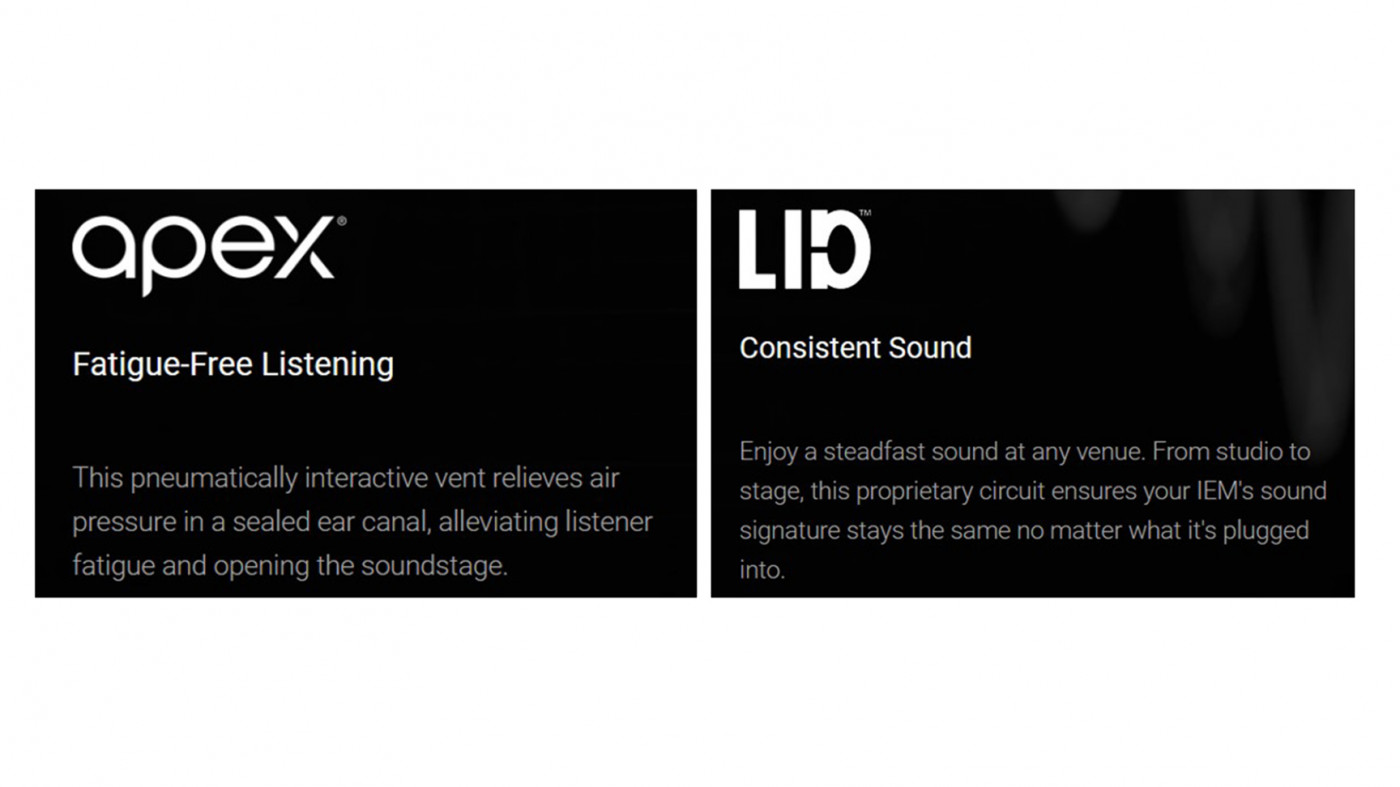
APEX Modules – m15, m20, and mX
A number of 64 Audio models have something called the APEX system – namely the U6t, U12t, Nio, U18s, and U18t. APEX is the name that 64 Audio has given to their interchangeable tuning modules. You get three modules in the box: the m15 (dark grey), m20 (silver), and mX (black) modules. Each module is placed on the back of the IEM directly behind the nozzle and has a tiny vent in each of them. The primary effect of these tuning filters is to modulate the bass response.
The m15 and m20 modules are largely similar, with about 1 – 2 dB more subbass added on the m20 filter. The general effect is a little more subbass rumble and impact with a tradeoff of a tiny bit of bass cleanliness. The mX module is unique – it flattens the bass response and transform the IEM into a much more midrange focused IEM. Below is the frequency response graph of the U12t with each of the APEX modules to illustrate this effect.
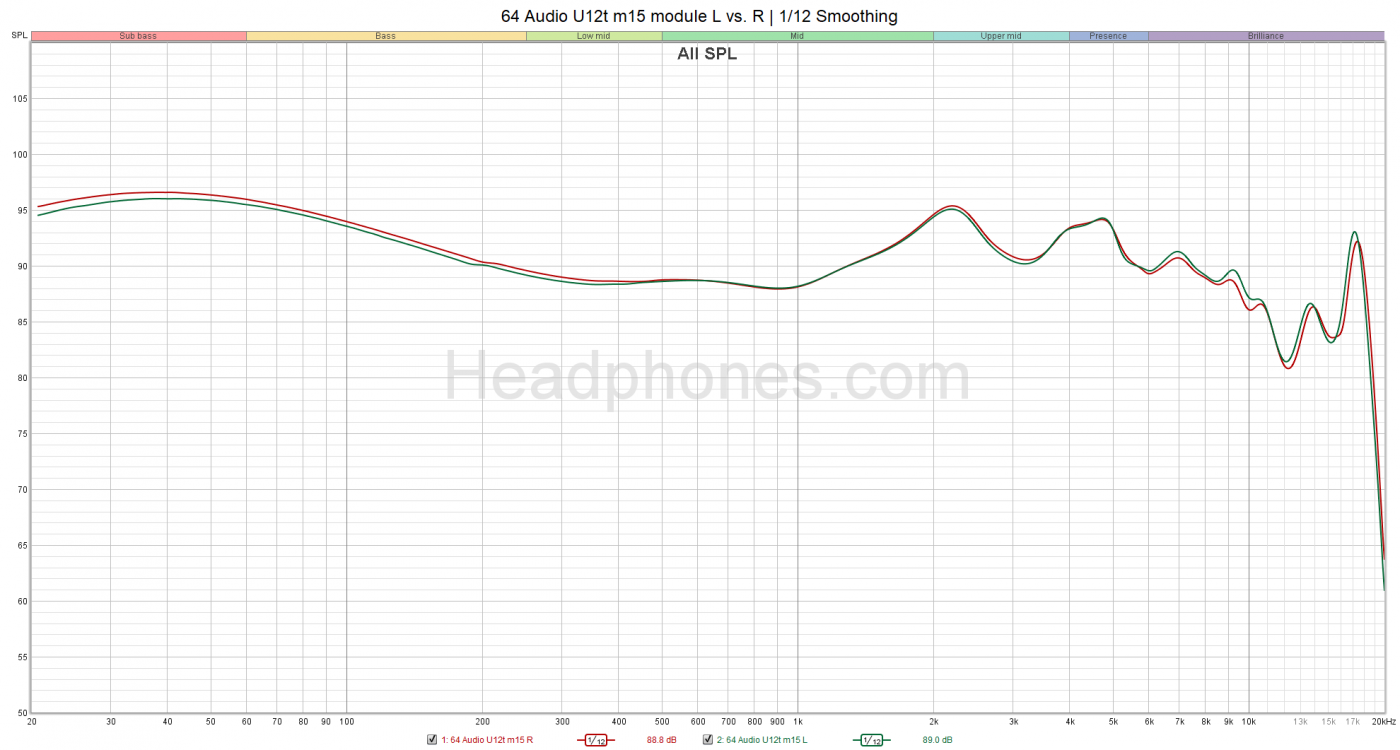
Since 64 Audio does include these APEX modules in the box ($99 value individually, I should mention), it’s definitely worth trying out to see which you enjoy. The difference between the m15 and m20 are small but noticeable enough that one would have a preference over the other. There is one other module, the m26 (orange) module that 64 Audio sells separately. They call it a “solid plug” meaning there is no vent hole in it. Unfortunately, I can’t comment on the effects of that one as I’ve never tried.
Ranking Them
And now its time to rank and summarize all seven of the IEMs I’ve reviewed to see how they stack up against one another. I’ve ordered them from worst to the best with a short explanation for each. Of course, price/performance and personal preference are factors I consider but as you shall see, won’t actually matter much for this list.
64 Audio tia Fourté – Different is Not Better
Driver Set-up: 1 dynamic driver + 3 balanced armatures
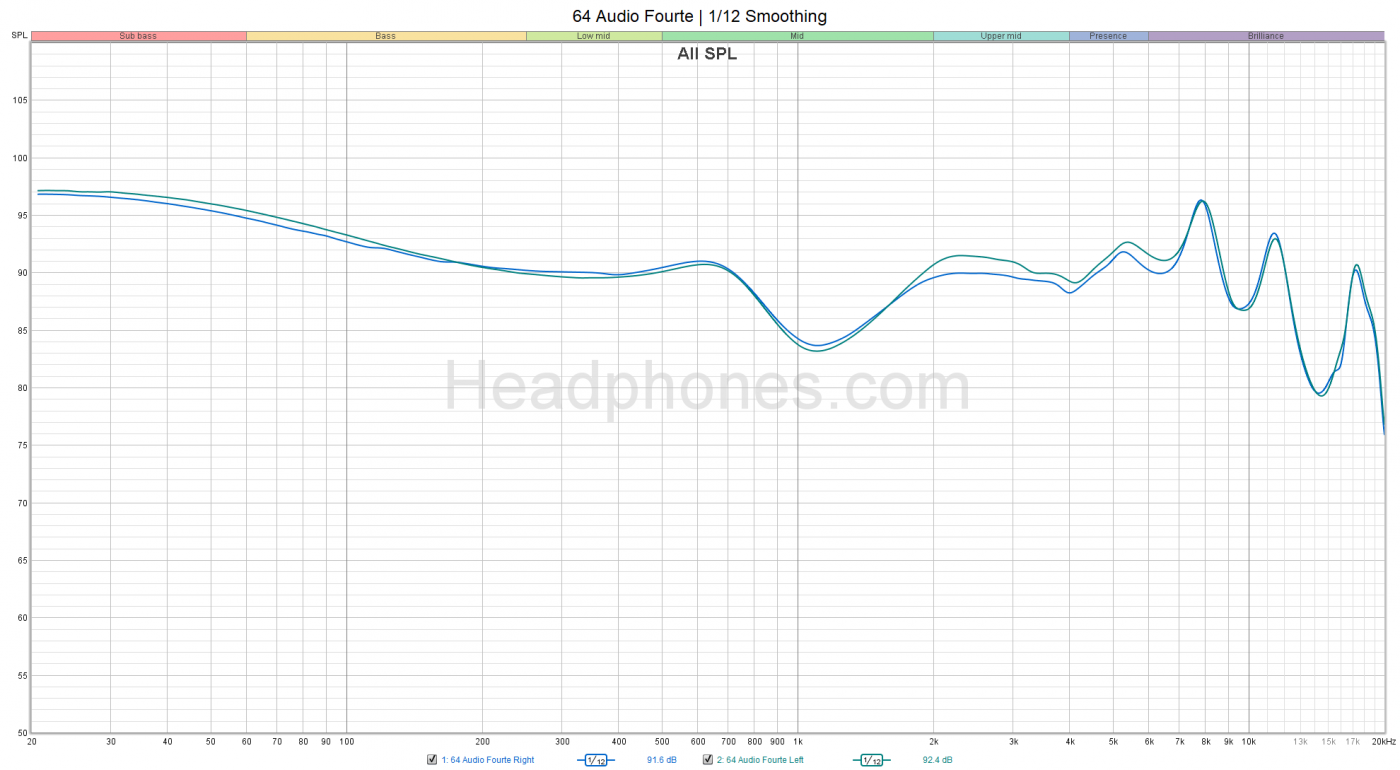
- Reasons to buy
- Great Soundstage and Imaging
- Reasons not to buy
- Price
- Overall Tuning is Extremely Wonky
Being unique doesn’t make you good. The 64 Audio tia Fourté is the perfect exemplification of that. Not only is it at the bottom my list, it’s also the most expensive IEM of the 64 Audio line-up at an asking price of $3,599. So what do you get for that price? Atrocious tonal balance but surprisingly good technical performance. Its hard to describe its tuning because it’s so out of the ordinary there’s no good frame of reference. Suffice it to say, it somehow manages to make me feel like I’m missing a good 20 – 30% of my music.
Beyond its questionable tuning, however, is a glimpse of what it could have been as 64 Audio’s flagship product. The horizontal soundstage is superb while stage height and depth are very respectable indeed. Resolution, at times, demonstrates a shocking level of finesse. Unfortunately, the rest of the Fourté’s technical ability is held back by its poor tuning. All of this just begs the question of how the Fourté made it out of the lab. 64 Audio clearly knows how to make a technically impressive IEM. And based on the other 64 Audio products, they also know how to create enjoyable tunings. So how did they miss the mark so badly on their own flagship?

All that said, there are people who do genuinely enjoy the Fourté. To borrow a classic salesmen’s phrase, it doesn’t matter what I think, what matters is what you think. If you have the chance to demo it, I will always advocate for giving it a listen yourself. I just can’t recommend it given its exorbitant price and poor sound quality.
Read my full review of the 64 Audio tia Fourté
Buy the 64 Audio tia Fourté at headphones.com
64 Audio Duo – Novelty
Driver Set-up: 1 dynamic driver + 1 balanced armature
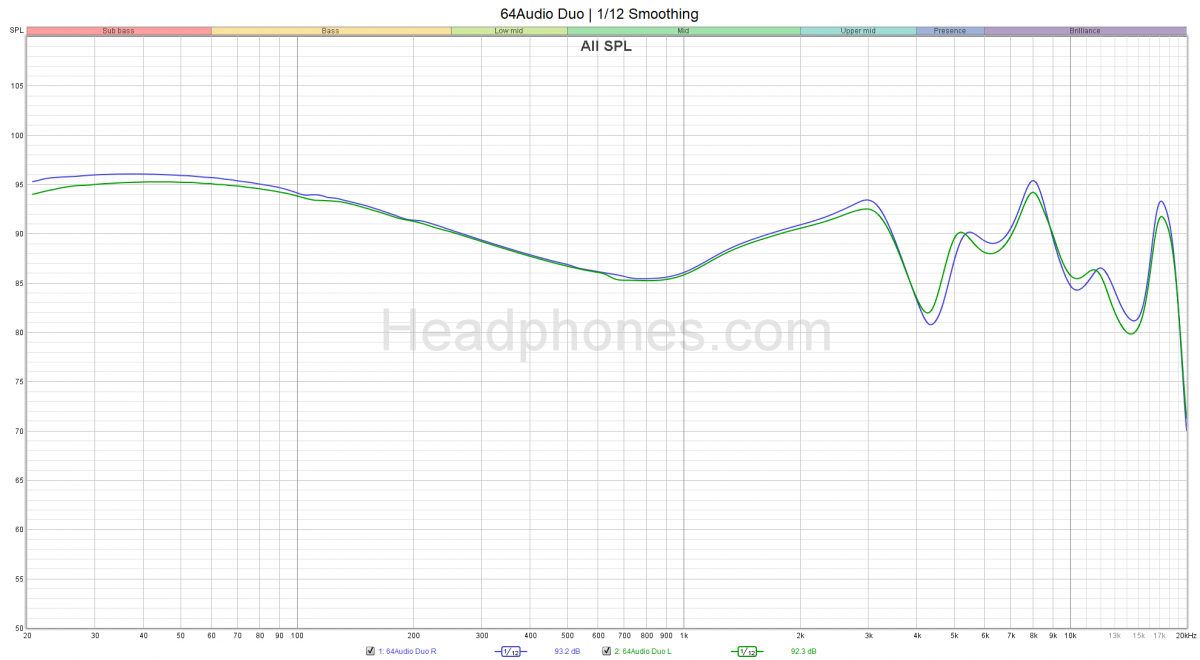
- Reasons to buy
- Unique Sound Presentation for a Different Audio Perspective
- Reasons not to buy
- Novelty Wears Off
- Technical Performance is Middling
On the flip side, the Duo is an example of when being unique can be an asset. When I first heard the Duo, I did not like it. I had to pause my listening session and switch to a comfort IEM for a palate cleanse. Its tuning definitely needs an adjustment period. Like the Fourté, the Duo forgoes traditional tuning guidelines. But unlike the Fourté, it doesn’t stray so far that it becomes tonally unviable. Its tuning is novel enough that it provides a fresh perspective into familiar tracks. Different instruments are emphasized and deemphasized to in a way that forces me to take notice of what they’re doing in the music. But this is a double-edged sword; the more I got used to the Duo’s tuning, the less engaging it became as that novelty wore off. On top of this, the Duo is the weakest 64 Audio IEM when it comes to technical performance. While it still has solid staging, its resolution is limited. Layering, instrument separation, etc. are generally fine but nothing to write home about.
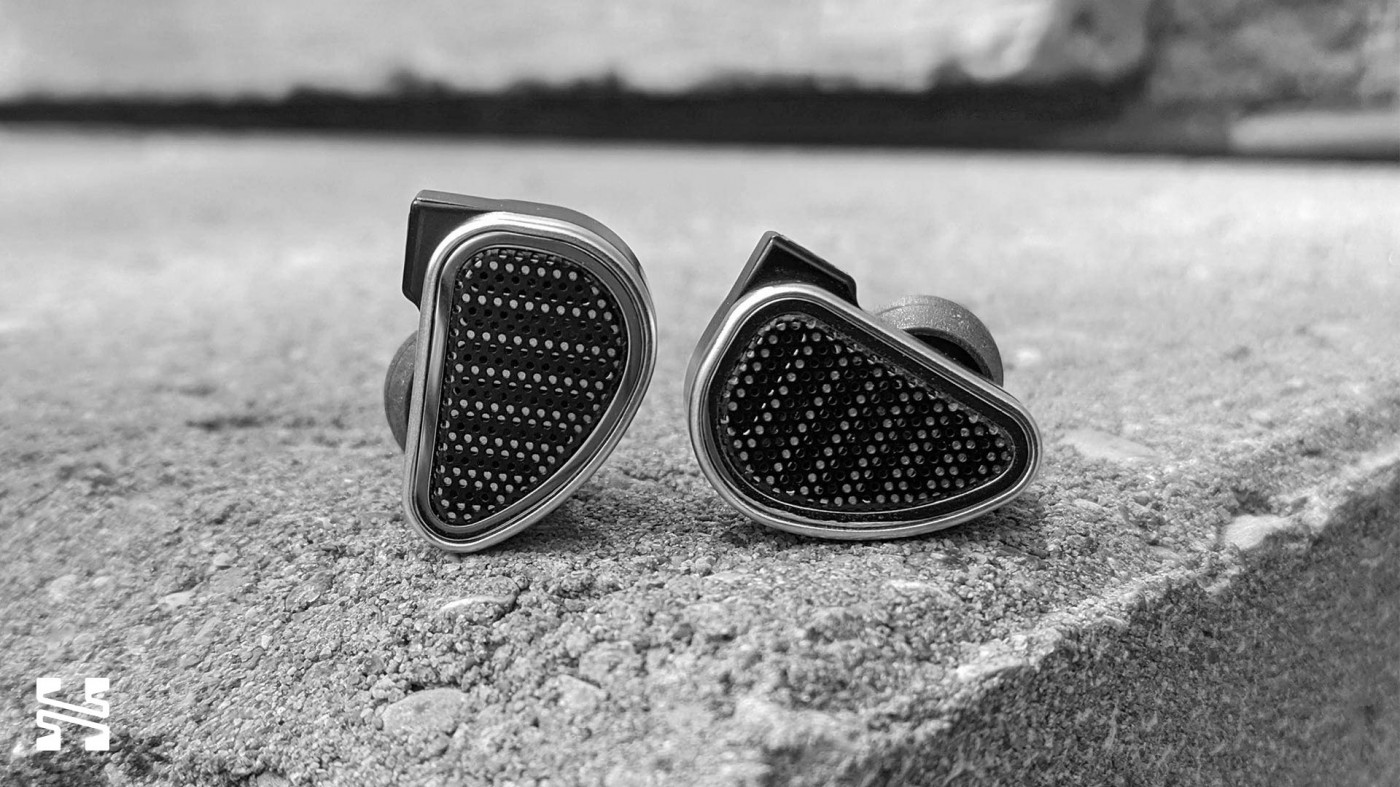
Thus, the Duo is best served as a complementary IEM to your daily driver. One you’d swap out every now and then for a different type of sound. For that use case, I can at least give it a soft recommendation. But at an asking price of $1,199, it isn’t exactly cheap. I’ll let you decide if it’s worth it. Personally, I would put that money towards other gear instead.
Read my full review of the 64 Audio Duo
Buy the 64 Audio Duo at headphones.com
64 Audio U6t – The Benchmark
Driver Set-up: 6 balanced armatures
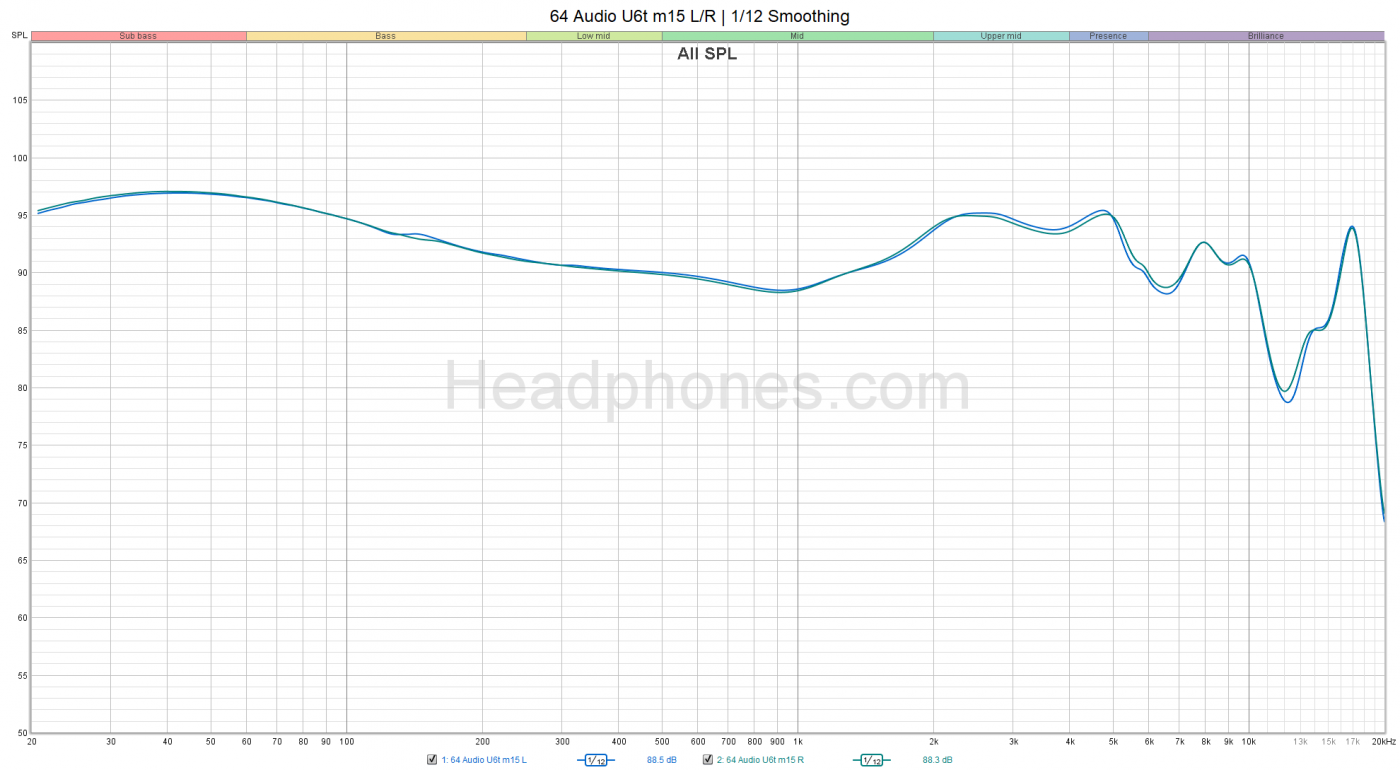
- Reasons to buy
- Solid Technical Performance for the Price
- Warm, Relaxed Tuning
- Safe, All-Rounder Choice
- Reasons not to buy
- Competition with the Symphonium Helios and Sony IER-M9
With the U6t, we finally step into the realm of the 64 Audio products that I can firmly recommend. The U6t is a good IEM. And to be honest, that’s all there really is to say about it. It’s not a technical champion by any means but is a good benchmark for the thousand-dollar mark, provided you can find one at that price instead of its usual $1,299 MSRP. While I do think the Symphonium Helios is a better pick for pure sound quality at that price, the increased comfort and relaxed tuning of the U6t is an attractive proposition.

The U6t personifies everything that makes a 64 Audio IEM. It has a solid technical foundation built on good staging, bass dynamics, resolution, and separation. A warm, laid-back tuning that’s inoffensive and enjoyable. It sports 64 Audio’s APEX system if you’d like to try out the different tuning filters. Really, the only mark against it is that it’s clearly the little brother in the line-up. When up against the rest of the IEMs on this list, the U6t fails to stand out in any way. While it’s hard to go wrong with the U6t, if you’re serious about the hobby I have a good feeling you’ll soon be looking at its brethren for an upgrade.
Read Resolve’s and my full review of the 64 Audio U6t
Buy the 64 Audio U6t at headphones.com
64 Audio U18s – Honorable Mention
Driver Set-up: 18 balanced armatures
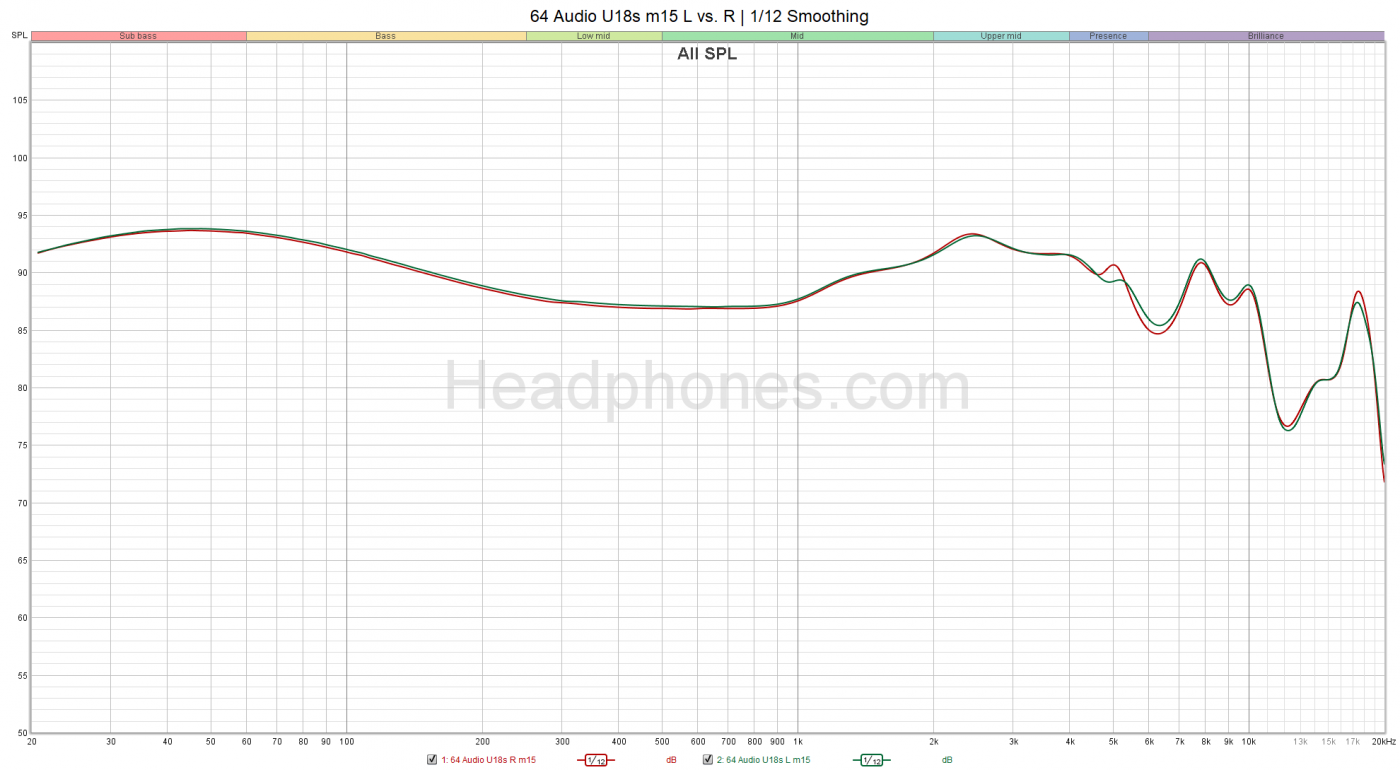
- Reasons to buy
- Reference Level Tuning
- Excellent Technical Performance
- Great Soundstage
- APEX Modules
- Reasons not to buy
- Price
- Upper Treble Feels Exaggerated
If the U6t is the little brother of the 64 Audio line-up (ignoring the drunk Fourté and Duo uncles), the U18s is the responsible older brother. It takes the U6t’s tuning and improves noticeably on it to reach a reference class level status. The bass shelf flattens nicely at 300 Hz while the upper mids are beautifully balanced. The treble is deemphasized to give the U18s a darker overall tone. The one oddity of its tuning is a strange high upper treble wispiness. As a whole, I’d say the best tuned IEM of the 64 Audio line-up.
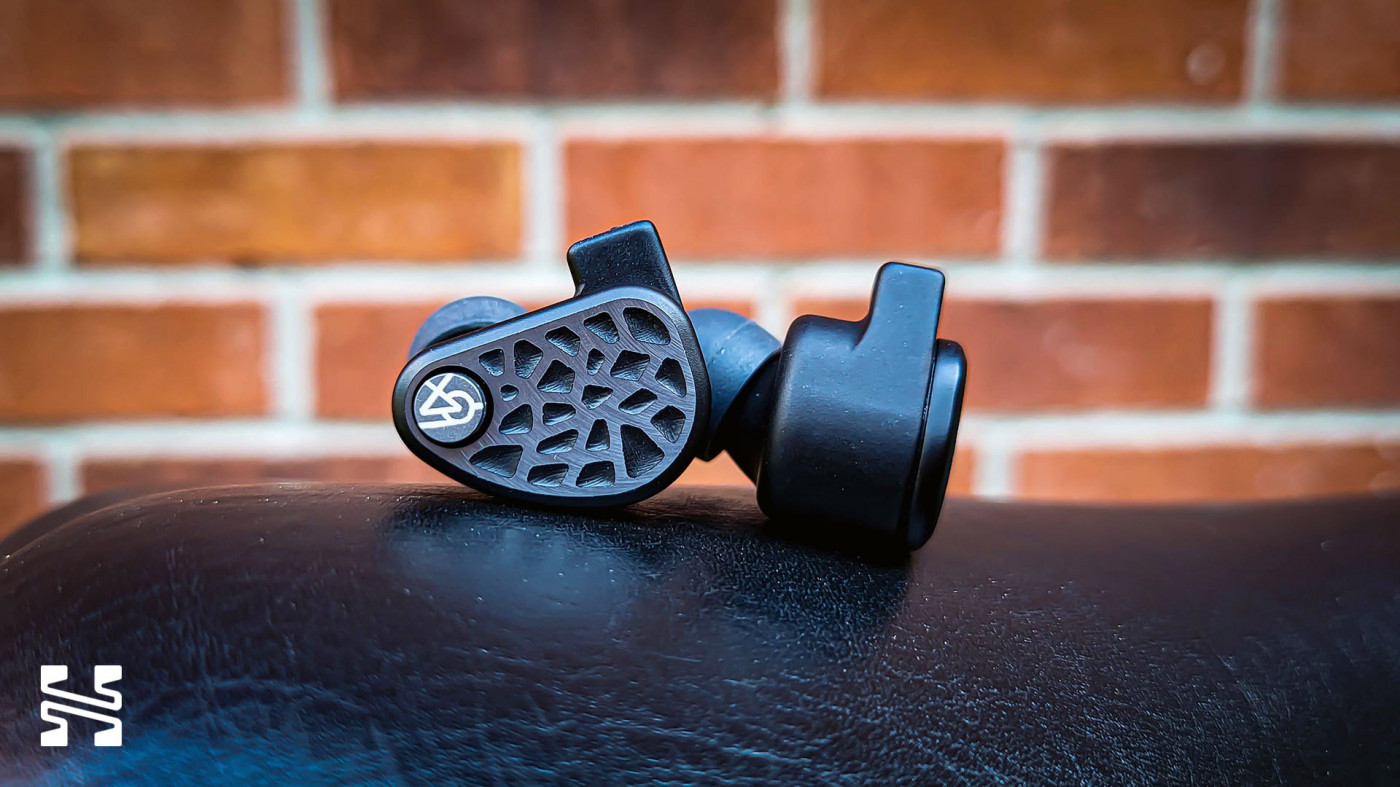
On a technical level, the U18s performs exceptionally well, albeit in an understated manner. Though its unlikely to wow you at first listen, the U18s quietly excels in pretty much every technical parameter and you can count on it to do the job. However, it doesn’t take first place in any. Nor does it have an X-factor that clearly sets it apart. It is for these reasons that the U18s comes 4th in this list. At a list price of $2,999, it’s the 2nd most expensive IEM in 64 Audio’s line-up. I don’t think it does quite enough to justify its MSRP. But make no mistake, the U18s is a superb IEM. It’s an honourable mention just a little outside the top 3 and I think on any given day one could reasonably prefer the U18s among the final four.
Note: There exists the 64 Audio U18t as well which I hadn’t had a chance to cover. The U18s is the newer, more relaxed, “stage” version of the U18t.
Read my full review of the 64 Audio U18s
Buy the 64 Audio U18s at headphones.com
64 Audio tia Trio – Powerhouse
Driver Set-up: 1 dynamic driver + 2 balanced armatures
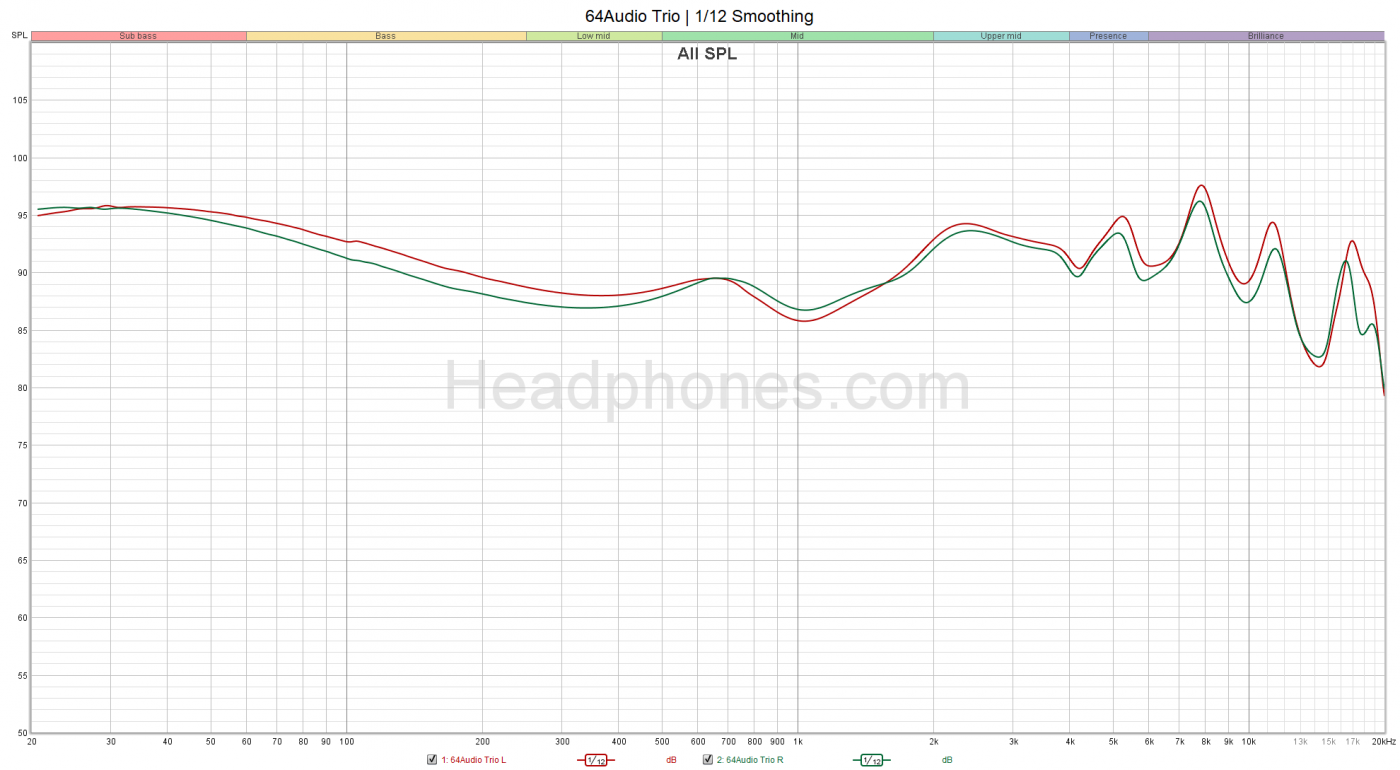
- Reasons to buy
- Highly Engaging Sound Presentation
- Great Bass Response
- Excellent Resolution
- Reasons not to buy
- Slightly Wonky Midrange Tuning
The Trio was the first 64 Audio IEM to wow me. It has a rather aggressive presentation to its sound that immediately caught my attention. Its dynamic driver bass is brash and lively. Its midrange is coloured and engaging. The treble is energetic and airy, though peaky at times. While its frequency response does look wonky on a graph, the Trio is an IEM I greatly enjoyed my time with. More than sitting down and dissecting its sound, I just wanted to listen to music. Rather than just its tuning or technical prowess, the Trio won me over with its raw sonic presentation. It won’t be for everyone, but I do strongly encourage anyone who is able to demo it give it a good try. Let’s put it this way: of all the IEMs I’ve reviewed, the Trio is one of the two that I wished I could keep.

And that’s not to say its technical performance is lacking. Unlike the U18s, the resolution of the Trio is frontloaded. It’s not a subtle IEM by any means. Its coherency and nuance makes it deserving of its top 3 spot on this list. As I noted in my review, the Trio made me ask questions like “I wonder what the size of that splash cymbal is” instead of fretting over if I thought the treble was too sharp or not. When I’m drawn into the music rather than trying to review the product itself, that is the mark of a great IEM. Even looking back now as I write this article, I want to listen to the Trio again just to confirm if I just don’t have rose coloured glasses on.
Read my full review of the 64 Audio tia Trio
Buy the 64 Audio Trio at headphones.com
64 Audio Nio – The Basshead’s Choice
Driver Set-up: 1 dynamic driver + 8 balanced armatures
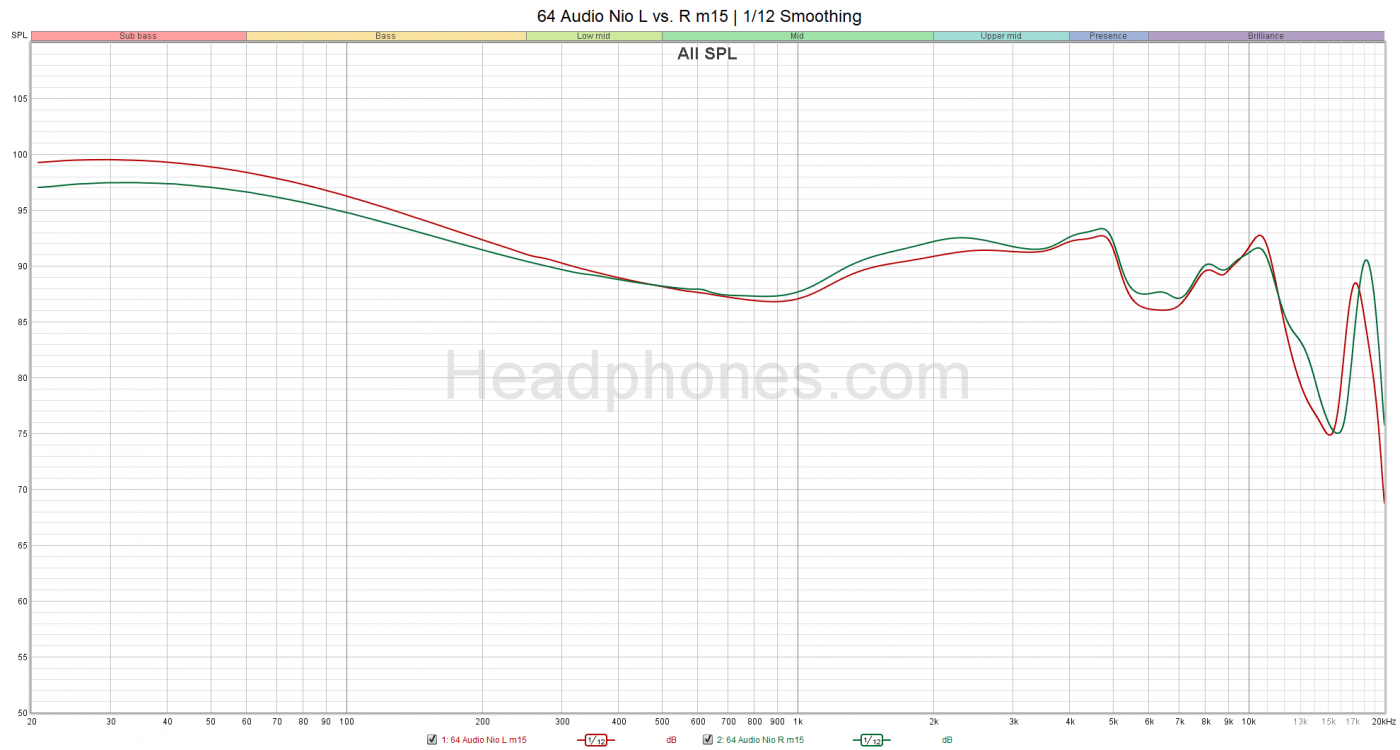
- Reasons to buy
- Extremely Enjoyable Basshead Tuning
- Great Soundstage and Imaging
- Excellent Bass and Dynamics
- Reasons not to buy
- Lacking Treble Brilliance
The Nio was a surprise hit for me. I had no idea what to expect from it. It seems to exist on its own and doesn’t follow any naming scheme i.e. Duo/Trio/Fourté or U6t/U12t/U18s. Yet it takes 2nd place on this list. Tonally, the Nio is a basshead IEM. Its bass response is the first thing you’ll notice when listening to it. It booms with a larger-than-life sound. The midrange of the Nio is consequently fairly thick, with vocals that are pulled back in both volume and stage presence. While the treble isn’t its primary draw, the Nio doesn’t neglect it. There’s a sizable mid treble hump that balances out the low-end energy.
The Nio’s technical performance strikes a nice balance between the U18s’ reserved nature and the Trio aggressive sound. Its resolution isn’t so understated that you need a quiet listening session to truly appreciate it while it isn’t so upfront that there isn’t much left to explore upon repeated listens. The most impressive part of the Nio however is its imaging. Of the 64 Audio IEMs, I think it has the best imaging prowess. Its stereo panning makes me feel like I’m right on stage rather than listening in front of it. The drums in particular makes me imagine like I’m the one behind the kit pouring my heart out. Not many IEMs can maintain the level of technical prowess the Nio showcases with its bass heavy tuning.
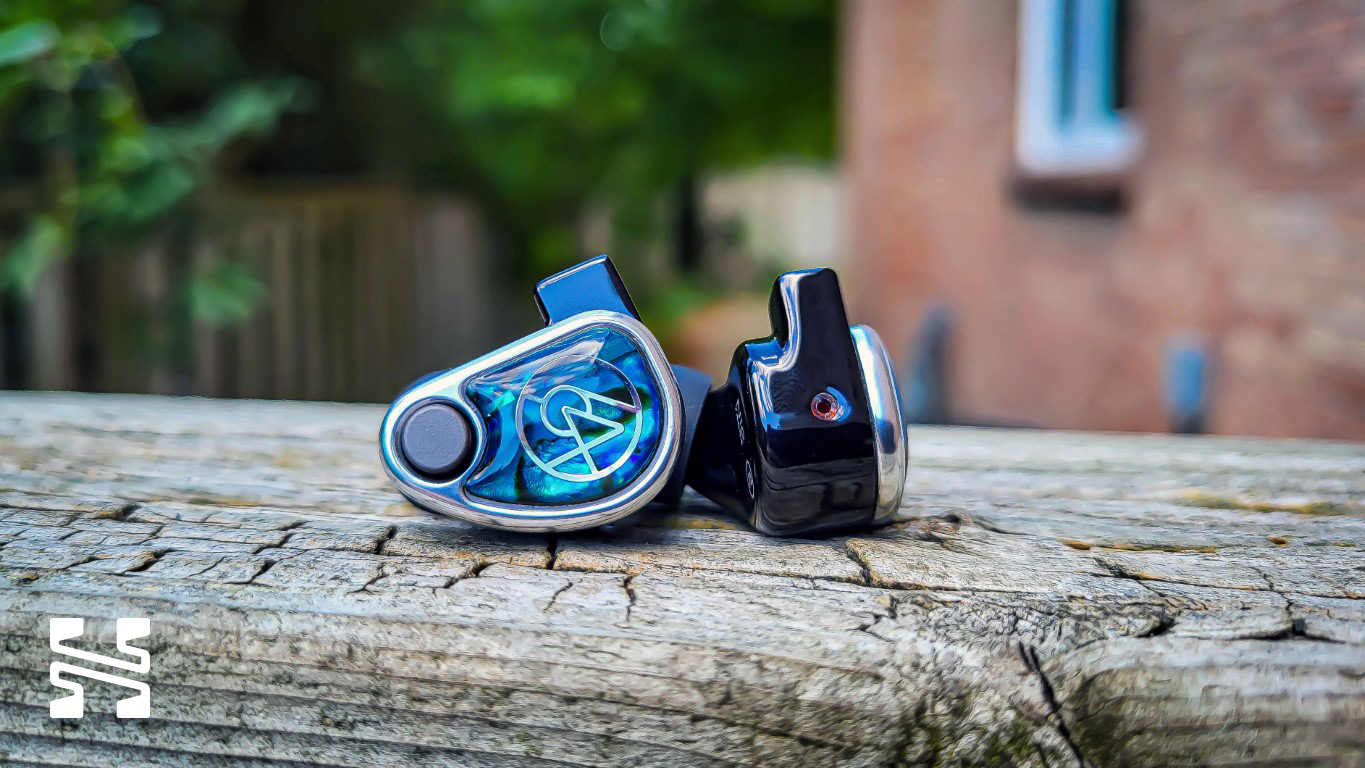
Like the Trio, the Nio is an extremely enjoyable IEM. I’m reluctant to remove it at the end of a listening session. I keep telling myself one more song before I take them off. It’s just so engaging to listen with. Above, I mentioned two IEMs I wished I could keep. The Trio was the first. The Nio is the second. Unfortunately, I didn’t get a chance to actually A/B them side by side. If I had to pick, I’d lean towards the Nio but that could very well be recency bias talking. And with that, it also happens to be my favourite IEM of the bunch.
What makes the Nio higher on the list is three factors: 1) Better overall tonality; 2) Slightly better technical performance; and 3) Cheaper price. Coming in at $1,699, the Nio is the 3rd cheapest IEM on the list here, a whole $500 cheaper than the Trio. Not to mention the APEX modules it comes with and a more robust 2-pin connector (where the older 64 Audio IEMs like the Trio sometimes failed). Even if their sound quality were equally preferable, the Nio presents the best value of all the 64 Audio IEMs.
Read my full review of the 64 Audio Nio
Buy the 64 Audio Nio at headphones.com
64 Audio U12t – Worthy of the Throne
Driver Set-up: 12 balanced armatures

- Reasons to buy
- Exceptional Resolution and Refinement
- Great Soundstage and Imaging
- Excellent Bass Quality and Dynamics
- Reasons not to buy
- Minor Oddities in the Treble
Finally, we come to the number one IEM on this list. The venerable 64 Audio U12t. Released 5 years ago alongside the Trio, the U12t has aged remarkably well. It feels just as modern as its new siblings. It is also within those 5 years that it has claimed its place near the top of almost every reviewer’s list. It’s an unequivocally exceptional IEM. To be honest, part of the reason I started this journey through the 64 Audio line-up was specifically because I wanted to ascertain for myself if the U12t was truly worth its reputation. It is.
So what exactly makes the U12t so good? Not its tuning. Don’t get me wrong, the U12t is well tuned. It’s a jack-of-all trades tuning with a sizable bass shelf and mild midrange. There’s little to complain about its tuning overall except for a few nitpicks in the treble and upper mids dip. And that’s pretty much where the complaints end.

What puts the U12t at the top is its technical prowess. First and foremost is its resolution and coherency. Its sheer transparency is a step above every IEM on this list. Like the Nio, the U12t has found a sweet spot in its presentation. Instruments consistently have an added note or trailing tone that adds greater depth to their character. Even if you aren’t looking for it, the U12t displays it. It showcases its resolving ability in a completely effortless manner. When I listen to high end gear, I’m often disappointed that there isn’t a meaningful improvement in resolution. The U12t does not disappoint.
The second thing that sets the U12t apart is its bass dynamics and quality. There’s a stunning amount of gravity and weight to the bass that goes beyond its sizable bass shelf. I can safely say that the U12t’s bass quality is one of the best in the industry, BA or not. While some may still prefer a DD bass response ala the Trio or Nio, I think the improvements in nuance and control is a fair trade-off. What’s confuses me is why the U18s doesn’t achieve the same level of bass performance as the U12t when they’d presumably use similar drivers. The U18s has same nuance and control but lacks the dynamics that makes the U12t such a favourite among the community.
As for the rest of its technicalities, the U12t is often either at the top or just a step below. It has an expansive soundstage, great imaging, and superb layering. The final factor that puts the U12t at the top of this list is how it seamlessly integrates all of its strengths into one cohesive unit. It’s an IEM that’s more than the sum of its parts and when we look at the rest of the IEM market, there are very few IEMs that can challenge the U12t as a complete package. Even as flagship IEMs crack the four- or five-thousand-dollar mark nowadays, the $1,999 U12t still holds its ground. While the U12t isn’t my favourite 64 Audio IEM, I have nothing but respect for what it brings to the table.
Read my full review of the 64 Audio U12t
Buy the 64 Audio U12t at headphones.com

Conclusion
And there you have it. A walkthrough of 64 Audio’s IEM line-up. While I wouldn’t call myself a 64 Audio fanboy, I do like the fact that they make very practical IEMs. The majority of their IEMs have great tuning, excellent technicalities, superb comfort, APEX modules, and LID technology. For the majority of people, you can’t go wrong with any of the top 5 IEMs on this list. And it just so happens that the top 4 are all genuinely superb IEMs that are among the upper echelons of what the market has to offer.
While the U12t is the ultimately winner, the U18s, Trio, and Nio are all still highly competitive IEMs. As always, if you have a chance to demo any of them, please do. You never know how an IEM will speak to you before you hear it. If I hadn’t heard any of them, the U18s would likely have been my first choice, followed by the U12t based on frequency response alone. Yet I ended up enjoying the less conventionally tuned Trio and Nio over them. If you unfortunately don’t have a way to listen before you buy, I hope this article will provide you with a good sense of direction.
--
Join the discussion for 64 Audio IEMs here on our community forums!
--
